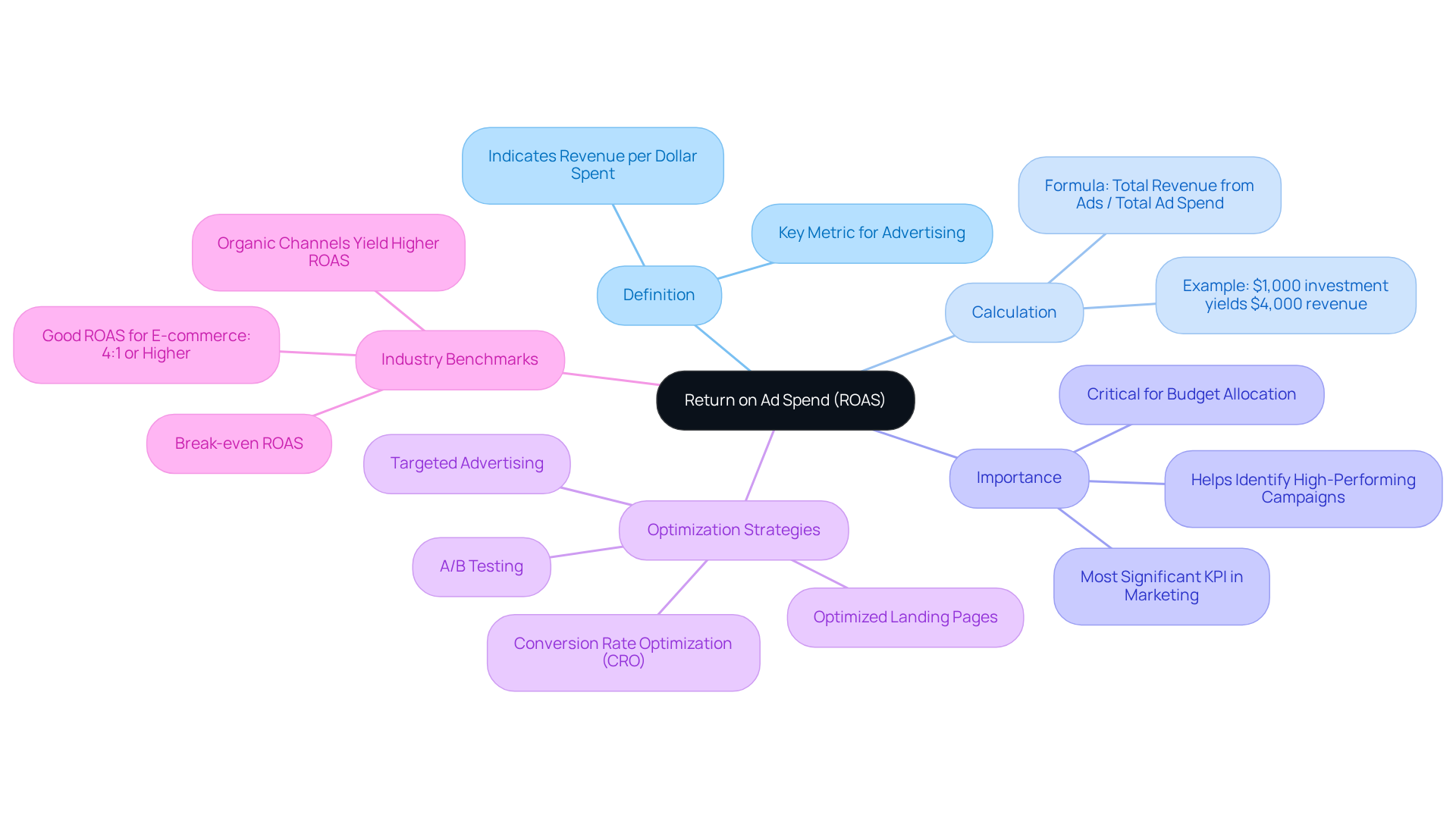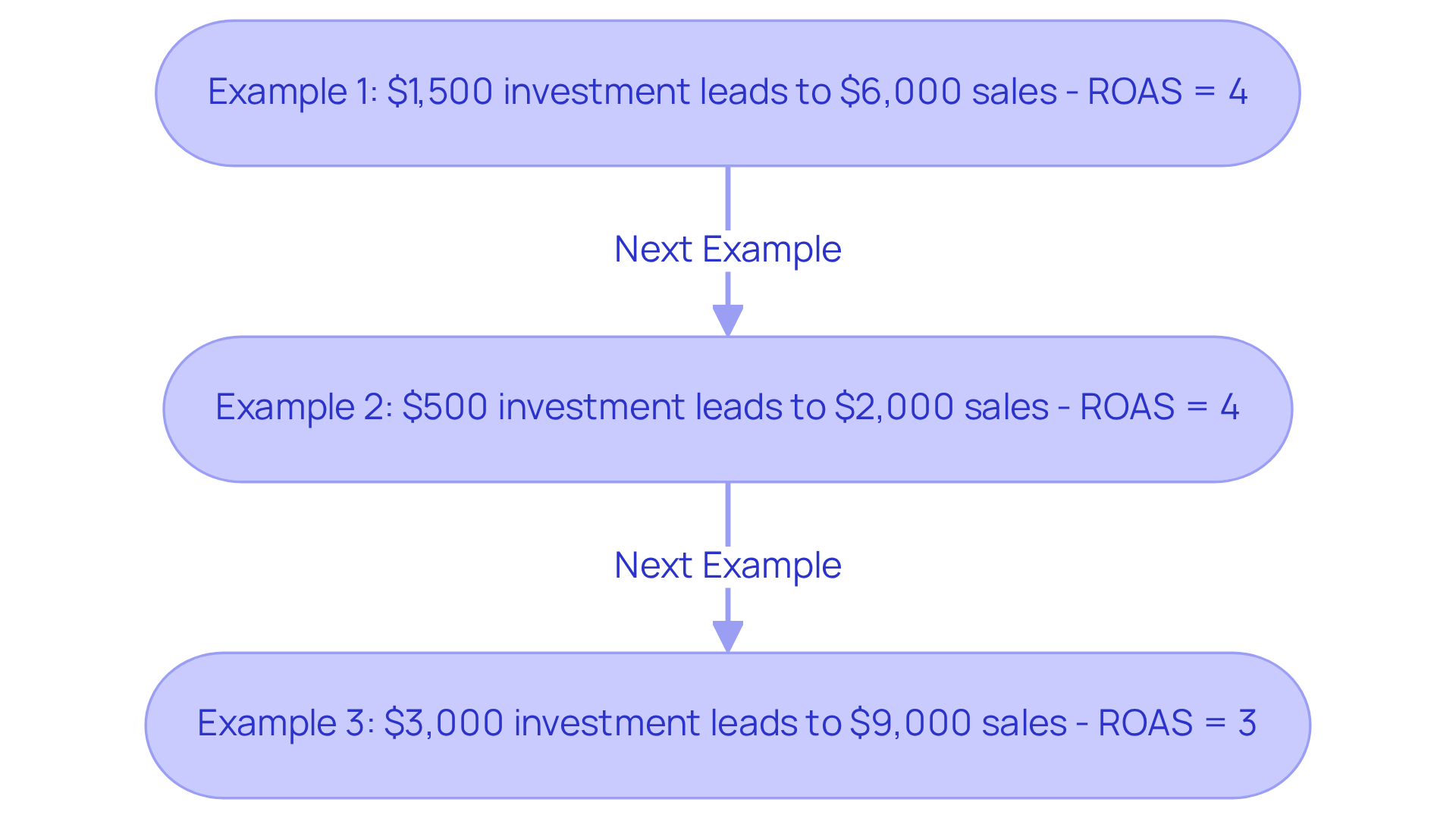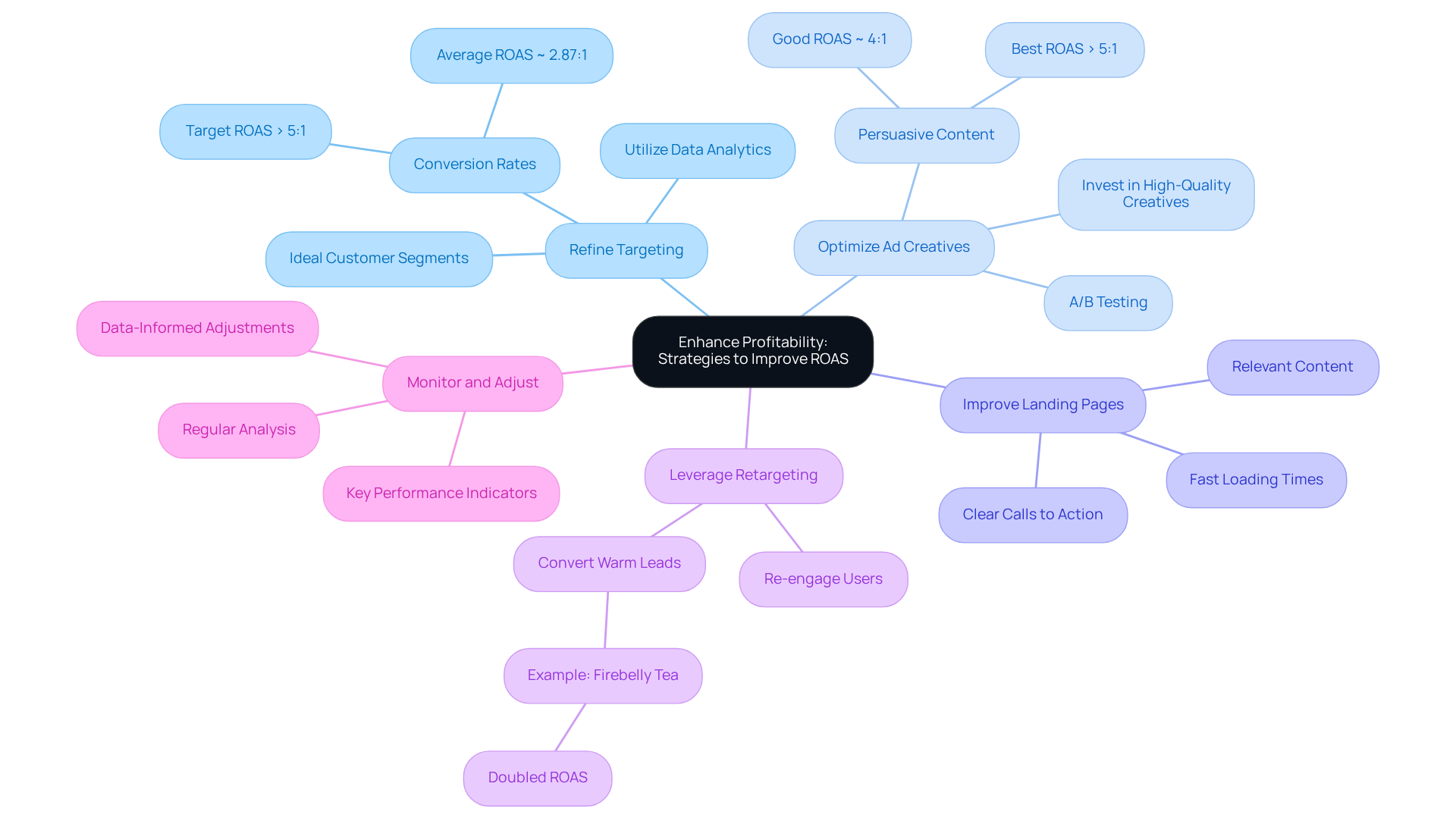
Overview
This article serves as an authoritative guide on calculating Return on Ad Spend (ROAS) specifically for direct-to-consumer (DTC) brands. Understanding ROAS is crucial for assessing the effectiveness of advertising strategies and determining profitability.
The article presents the calculation formula clearly, supplemented by practical examples that illustrate its application in real-world scenarios. Furthermore, it delves into effective strategies for optimizing ROAS, such as:
- Refining targeting methods
- Enhancing ad creatives
By emphasizing these elements, the article underscores their significant contribution to improved financial outcomes for DTC companies. Readers will find actionable insights that empower them to elevate their advertising performance.
Introduction
Understanding the intricacies of Return on Ad Spend (ROAS) is essential for direct-to-consumer (DTC) brands aiming to thrive in a competitive marketplace. This vital metric not only measures the effectiveness of advertising campaigns but also serves as a compass for budget allocation and strategic optimization. However, many brands struggle with accurately calculating and interpreting their ROAS, often leaving potential profits on the table. DTC brands must harness the power of ROAS—not merely to measure success but to drive sustainable growth.
Define Return on Ad Spend (ROAS)
Return on Ad Investment is a crucial performance metric that quantifies the revenue generated for each dollar invested in promotional activities. To understand how to calculate ROAS, use the formula: Total Revenue from Ads divided by Total Ad Spend. For instance, if a company invests $1,000 in promotion and subsequently earns $4,000 in revenue, the return on ad spend would be 4:1. This signifies that for every dollar spent, four dollars are earned in return.
In 2025, understanding return on advertising spend is imperative for direct-to-consumer companies, as it allows them to assess the effectiveness of their promotional strategies and make informed decisions regarding budget allocation and campaign optimization. Successful direct-to-consumer companies consistently evaluate their return on ad spend to pinpoint high-performing campaigns and effectively reallocate resources. By integrating Conversion Rate Optimization (CRO) strategies, such as those offered by Parah Group, brands can further enhance their return on advertising spend. Parah Group sets itself apart by prioritizing profitability and sustainable growth, focusing on strategies that reduce costs while improving margins, ensuring that promotional efforts yield significant conversions.
Industry benchmarks reveal that a favorable return on advertising spend for e-commerce businesses typically stands at 4:1 or higher, indicating substantial revenue relative to advertising costs. Marketing experts emphasize that focusing on return on ad spend enables brands to gauge the true financial impact of their promotional efforts, moving beyond superficial metrics like impressions or clicks. As Josh Stutt, head of marketing at The49, asserts, "Return on Advertising Spend is the most significant KPI in a marketing department, because ultimately, we’re here to assist our company in selling."
Furthermore, monitoring all factors influencing total revenue and advertising expenditure is essential for understanding how to calculate ROAS and ensure accurate return on advertising spend calculations. Techniques such as targeted promotion and A/B testing can significantly enhance return on ad spend, empowering companies to optimize their campaigns effectively. Understanding the concept of break-even return on advertising spend, where revenue equals advertising expenditure, is also vital for direct-to-consumer companies to avert losses.
By prioritizing return on ad spend and employing expert conversion rate optimization techniques, including tailored strategies and ongoing support, DTC brands can enhance their profitability and foster sustainable growth in an increasingly competitive landscape.

Calculate ROAS: The Formula Explained
To effectively calculate Return on Ad Spend (ROAS), it's important to understand how to calculate ROAS using the following formula:
ROAS = Revenue from Ads / Cost of Ads.
Consider this example: if your advertising campaign incurs a cost of $2,000 and generates $10,000 in revenue, this demonstrates how to calculate ROAS, which is ROAS = $10,000 / $2,000 = 5. This result indicates that for every dollar spent on advertising, you earn five dollars in revenue.
Regularly tracking how to calculate ROAS is essential for understanding campaign performance and making necessary adjustments to your strategies. A high return on ad spend, typically around 4:1 for online retail, signifies successful advertising efforts. Conversely, a lower return on ad spend may necessitate a reassessment of creative strategies or audience targeting.
By diligently monitoring return on ad spend, direct-to-consumer companies can refine their marketing strategies and enhance overall profitability.

Apply ROAS Calculation: Practical Examples
Here are several practical examples of ROAS calculations, complemented by insights from successful case studies:
-
Example 1: A DTC brand invests $1,500 in a Facebook ad campaign, generating $6,000 in sales. The formula for how to calculate ROAS is as follows: ROAS = $6,000 / $1,500 = 4. This indicates a return of $4 for every dollar spent, which illustrates how to calculate ROAS, aligning with the benchmark that a ROAS of 4:1 or higher is considered a strong baseline for many businesses.
-
Example 2: An influencer marketing campaign costs $500 and results in $2,000 in sales. To understand how to calculate ROAS, you can use the formula: ROAS = $2,000 / $500 = 4. This again shows a return of $4 for each dollar invested, reflecting the potential for higher returns in successful campaigns.
-
Example 3: If a brand spends $3,000 on Google Ads and earns $9,000 in revenue, the ROAS would be: ROAS = $9,000 / $3,000 = 3. This means the brand earns $3 for every dollar spent on ads, which shows how to calculate ROAS, indicating a positive return even though it is below the ideal benchmark.
These examples illustrate how to calculate ROAS using the return on ad spend formula in various advertising scenarios, highlighting the importance of monitoring returns to improve marketing strategies. Moreover, high-performing eCommerce companies frequently attain return on advertising spend ratios exceeding 5:1, as demonstrated by Parah Group's case studies, where labels have experienced notable enhancements in conversion rates and average order values through targeted CRO strategies, such as optimizing product pricing and executing post-purchase upsells. To enhance return on advertising spend precision, brands should keep a checklist of expenses and frequently assess revenue information.

Enhance Profitability: Strategies to Improve ROAS
To enhance profitability and improve ROAS, consider the following strategies:
-
Refine Targeting: Utilize data analytics to pinpoint and engage your ideal customer segments more effectively. This focused strategy can result in greater conversion rates and enhanced returns on advertising expenditure. Leading eCommerce stores strive for revenue-to-ad-spend ratios exceeding 5:1, while understanding how to calculate ROAS is important, as the average return on ad spend across eCommerce is approximately 2.87:1, providing a benchmark for evaluating your performance.
-
Optimize Ad Creatives: Invest in high-quality ad creatives that resonate with your audience. A/B testing different advertising formats and messages is essential for determining what enhances engagement and conversions. Persuasive content can greatly affect return on ad spend. As Dahn Tamir notes, understanding how to calculate ROAS reveals that a 4:1 ratio is considered good for most online retailers, while the best-performing eCommerce stores push for ratios above 5:1.
-
Improve Landing Pages: Ensure your landing pages are optimized for conversions. Key elements include fast loading times, clear calls to action, and relevant content that aligns with your ads. Effective landing pages are essential for understanding how to calculate ROAS, as they enhance user experience and boost conversion rates.
-
Leverage Retargeting: Implement retargeting campaigns to re-engage users who have previously interacted with your brand but did not convert. This strategy can significantly enhance your return on ad spend by converting warm leads, which illustrates how to calculate ROAS effectively, as retargeted customers are often more inclined to make a purchase. For example, Firebelly Tea effectively doubled their return on ad spend by enhancing their retargeting strategies.
-
Monitor and adjust by regularly analyzing how to calculate ROAS along with other key performance indicators. Use this data to make informed adjustments to your campaigns, reallocating budget to the highest-performing ads and channels. Ongoing oversight and data-informed modifications are crucial for enhancing return on advertising spend and attaining lasting profitability. As Elise Dopson emphasizes, success comes from understanding customer behavior through analytics and scaling what works while cutting underperforming initiatives.
To learn how to calculate ROAS, you can apply the formula: return on ad spend = (Revenue generated from ads / Cost of the ads). By applying these strategies, DTC brands can understand how to calculate ROAS and work towards long-term profitability.

Conclusion
Understanding and calculating Return on Ad Spend (ROAS) is crucial for direct-to-consumer brands that seek to maximize their marketing effectiveness and profitability. By employing the ROAS formula—Total Revenue from Ads divided by Total Ad Spend—businesses can obtain critical insights into their advertising performance. This metric not only underscores the financial impact of advertising investments but also facilitates the optimization of campaigns and resource allocation.
Key strategies for enhancing ROAS include:
- Refining targeting
- Optimizing ad creatives
- Enhancing landing pages
- Leveraging retargeting
Each of these tactics significantly contributes to driving higher returns on advertising expenditure, ultimately benefiting a brand's bottom line. Real-world examples further illustrate the importance of maintaining a favorable ROAS, with benchmarks indicating that a ratio of 4:1 or higher is ideal for many e-commerce businesses.
Prioritizing ROAS calculation and its associated strategies provides DTC brands with a pathway to sustainable growth and increased profitability. By continuously monitoring and adjusting advertising efforts based on ROAS insights, brands can enhance their marketing performance and ensure long-term success in an increasingly competitive landscape. Embracing these practices empowers businesses to make data-driven decisions that lead to improved financial outcomes and a stronger market presence.
Frequently Asked Questions
What is Return on Ad Spend (ROAS)?
Return on Ad Spend (ROAS) is a performance metric that measures the revenue generated for each dollar spent on advertising. It is calculated using the formula: Total Revenue from Ads divided by Total Ad Spend.
How do you calculate ROAS?
To calculate ROAS, divide the total revenue generated from ads by the total ad spend. For example, if a company spends $1,000 on advertising and earns $4,000 in revenue, the ROAS would be 4:1, meaning for every dollar spent, four dollars are earned in return.
Why is understanding ROAS important for direct-to-consumer companies?
Understanding ROAS is crucial for direct-to-consumer companies as it helps them evaluate the effectiveness of their promotional strategies, make informed budget allocation decisions, and optimize their campaigns for better performance.
What is considered a favorable ROAS benchmark for e-commerce businesses?
A favorable ROAS benchmark for e-commerce businesses is typically 4:1 or higher, indicating that the revenue generated is substantially greater than the advertising costs.
How can companies enhance their ROAS?
Companies can enhance their ROAS by integrating Conversion Rate Optimization (CRO) strategies, employing targeted promotions, and conducting A/B testing to optimize their advertising campaigns effectively.
What is the significance of monitoring factors influencing total revenue and advertising expenditure?
Monitoring all factors that influence total revenue and advertising expenditure is essential for accurately calculating ROAS and understanding the financial impact of advertising efforts.
What does break-even return on advertising spend mean?
Break-even return on advertising spend refers to the point where the revenue generated equals the advertising expenditure, which is important for direct-to-consumer companies to avoid losses.
How can DTC brands achieve sustainable growth through ROAS?
DTC brands can achieve sustainable growth by prioritizing ROAS, employing expert conversion rate optimization techniques, and continuously refining their advertising strategies to enhance profitability.
FAQs











